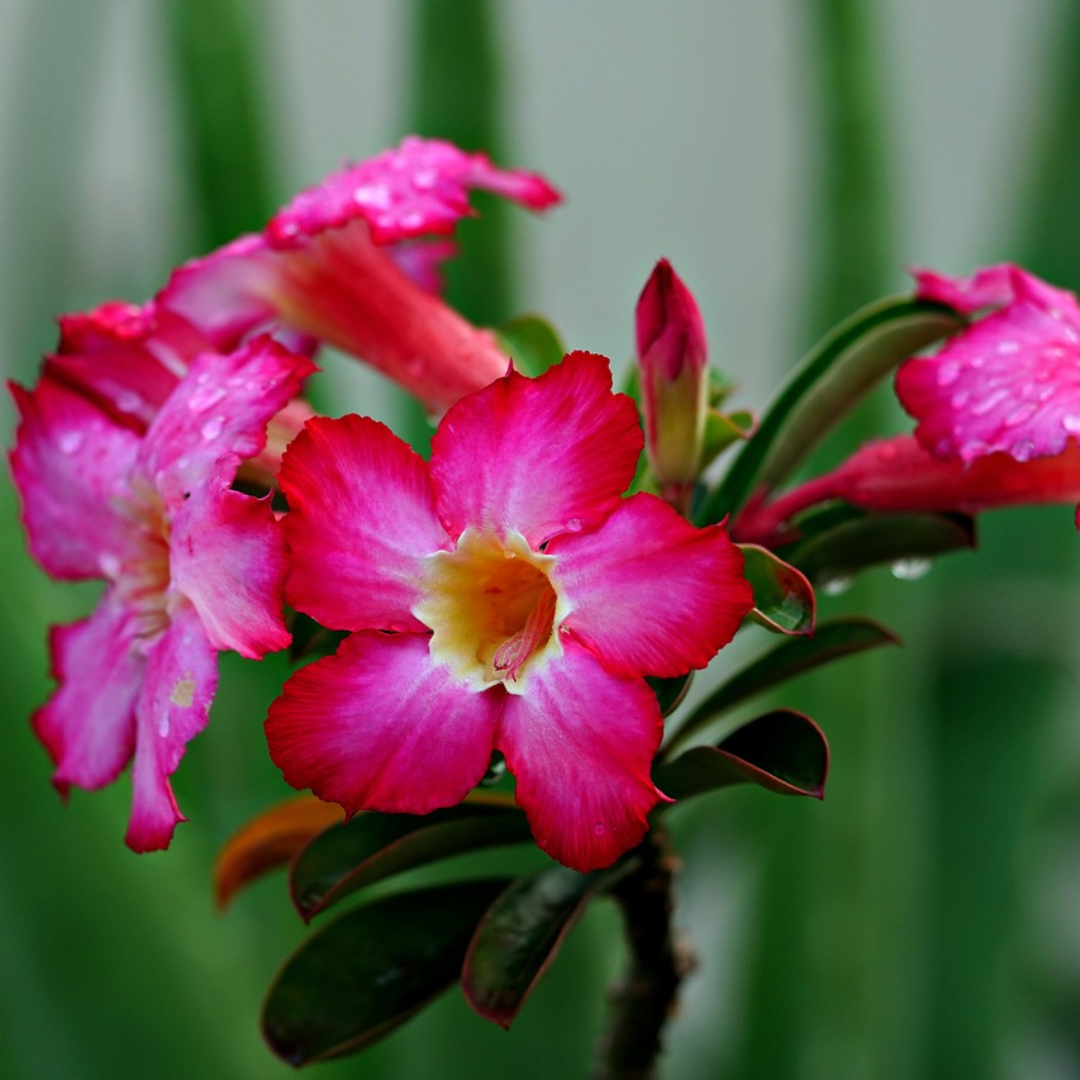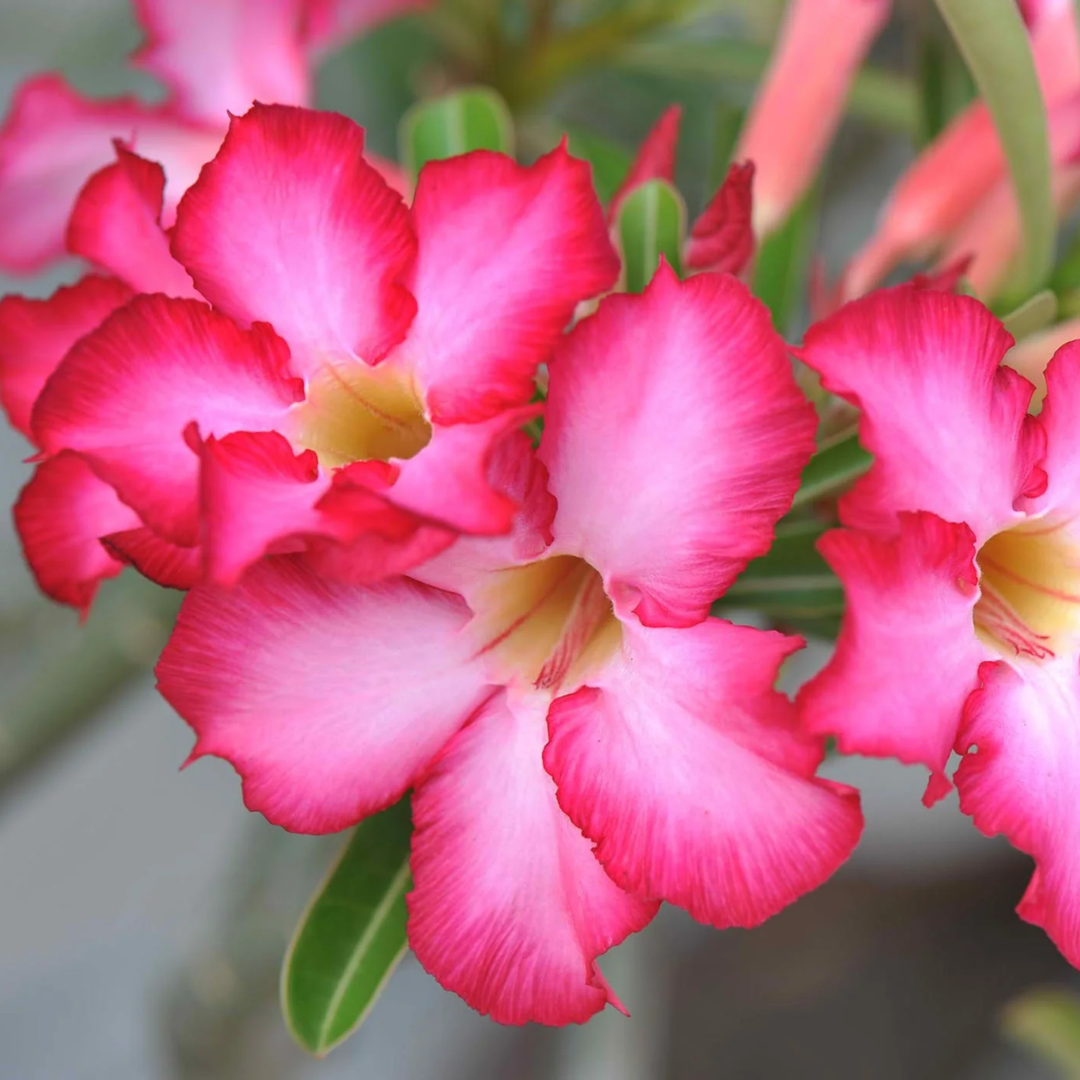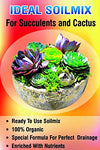



Green Paradise Adenium Plant Pink white Mix Color FLowering With Pot
Rs. 499.00
Guaranteed Safe Checkout
Green Paradise Offers Beautiful Adenium Plant For Bonsai
What is Adenium Plant
The Desert Rose is popular as an ornamental plant but not often seen as a bonsai. It is vigorous and healthy under the right conditions and with proper care. Native to East Africa, the Desert Rose is a small succulent tree that has fresh leaves and develops a bulbous base. It produces large pink and white or red flowers throughout the year when it gets enough sunlight. The Desert Rose adapts easily to growing in a pot, which makes it well suited for bonsai.
Adenium, also known as Desert Rose or Sabi Star, is a succulent plant native to arid regions of Africa and the Arabian Peninsula. It is a popular ornamental plant known for its attractive flowers and unique swollen trunk and branches.
Here are some key features and characteristics of the Adenium plant:
Appearance:
Adeniums have a distinctive caudex, which is a swollen, water-storing base that gives the plant a bonsai-like appearance. The trunk and branches may be thick and gnarled, and the overall growth habit can vary from shrubby to tree-like, depending on the variety. The leaves are thick, leathery, and usually oval or elliptical in shape.
Flowers:
Adeniums produce showy flowers in various colors, including shades of pink, red, white, and purple. The flowers are trumpet-shaped and have five petals that form a star-like pattern, hence the common name "Sabi Star." The flowers typically bloom in clusters at the ends of the branches and have a long blooming period.
Drought tolerance:
Adeniums are succulent plants, meaning they have specialized water-storing tissues that allow them to survive in dry and arid conditions. They are adapted to drought and can withstand extended periods without water. However, they also appreciate periodic watering to support healthy growth and flowering.
Sunlight requirements:
Adeniums thrive in full sunlight and require at least 6 to 8 hours of direct sunlight each day. They can tolerate high temperatures and are well-suited to hot, sunny locations.
Soil and potting:
Adeniums prefer well-draining soil that allows excess water to flow out quickly. A mixture of coarse sand, perlite, and regular potting soil is often recommended. Choose a pot or container with drainage holes to prevent waterlogging, as excessive moisture can lead to root rot.
Watering:
While Adeniums are drought-tolerant, it's important to water them when the soil has dried out completely. Water thoroughly and allow the excess water to drain away. Avoid overwatering, as it can cause root rot. During the dormant period, which is typically in winter, reduce watering frequency.
Pruning and shaping:
Adeniums can be pruned to maintain their desired shape and size. Pruning can help promote branching and encourage more flowers. It is best to prune during the active growing season to minimize stress on the plant.
Propagation:
Adeniums can be propagated through various methods, including seeds, stem cuttings, and grafting. Seeds are the most common method, but they may take a while to germinate. Stem cuttings are a faster way to propagate Adeniums, where a section of the stem is cut and allowed to callus before planting.
Pests and diseases:
Adeniums can be susceptible to pests such as aphids, mealybugs, and spider mites. Regularly inspect the plant for any signs of infestation and take appropriate measures, such as using insecticidal soap or neem oil, to control pests. Overwatering can lead to root rot and fungal diseases, so it's essential to ensure proper drainage.
Adeniums are popular as ornamental plants, particularly in tropical and subtropical regions. They can be grown in containers, making them suitable for balconies, patios, and indoor cultivation in well-lit areas. With proper care and attention, Adeniums can thrive and provide beautiful blooms year after year.
How to Grow Adenium Plant
To grow an Adenium plant (Desert Rose), you can follow these steps:
Planting medium:
Adeniums prefer well-draining soil mixtures. You can create a mixture using equal parts of coarse sand, perlite, and regular potting soil. This combination ensures good drainage while retaining some moisture.
Container selection:
Choose a pot or container with drainage holes to prevent waterlogging. The size of the container should be appropriate for the size of the plant, allowing some room for root growth.
Planting process:
1 . Fill the chosen container with the prepared soil mixture.
2 . Make a small hole in the center of the soil, large enough to accommodate the Adenium's root system.
3 . Gently place the plant in the hole, ensuring that the roots are spread out.
4 . Backfill the hole with soil, gently firming it around the base of the plant.
Sunlight and temperature:
Adeniums thrive in full sunlight. Choose a location where the plant can receive at least 6 to 8 hours of direct sunlight each day. They also prefer warm temperatures between 20 to 30°C (68 to 86°F) during the active growing season.
Watering:
Water the Adenium thoroughly after planting to settle the soil around the roots. Allow the soil to dry out almost completely before watering again. Overwatering can lead to root rot, so it's crucial to let the soil dry between waterings. During the dormant period (usually in winter), reduce watering frequency.
Fertilization:
Adeniums benefit from regular fertilization during the active growing season. Use a balanced, water-soluble fertilizer with an N-P-K ratio of around 10-10-10 or 14-14-14. Follow the instructions on the fertilizer package for the recommended dosage and frequency. Avoid fertilizing during the dormant period.
Pruning:
Pruning can help shape and promote branching in Adenium plants. It is best done during the active growing season. Trim back any leggy or excessively long branches to encourage a more compact and bushy growth habit. Remove any dead or diseased branches as well.
Pests and diseases:
Adeniums can be susceptible to pests such as aphids, mealybugs, and spider mites. Regularly inspect the plant for any signs of infestation, such as visible pests, sticky residue, or distorted growth. Treat infestations promptly with insecticidal soap or neem oil, following the instructions on the product label. Be careful not to overwater, as it can lead to root rot and fungal diseases.
Winter care:
Adeniums are sensitive to cold temperatures and may not tolerate frost. If you live in a region with cold winters, it's advisable to bring your Adenium indoors or protect it from freezing temperatures. Place it in a well-lit location indoors and reduce watering during the dormant period.
Propagation:
Adeniums can be propagated through seeds, stem cuttings, or grafting. Seeds are the most common method, but they require patience as they can take several weeks to germinate. Stem cuttings can be taken from healthy branches and allowed to callus before planting in a well-draining medium.
Remember to monitor your Adenium regularly for signs of growth, pests, or diseases. Adjust your care routine accordingly to ensure your plant remains healthy and thrives in its environment.
related products
Green Paradise Dwarf Variety Green Coconut Plant
Green Paradise Offers Dwarf Variety Green Coconut Plant About Green Coconut Plant The dwarf variety of green coconut plants, also known as the dwarf coconut palm or Cocos nucifera...
Rs. 699.00
Rs. 499.00
Green Paradise sweet tamarind plant Thai Tamarind dwarf seedling plant
Green Paradise Offers Tamarind Indica Healthy Plant About Tamarind Indica Healthy Plant Sweet tamarind, scientifically known as Tamarindus indica, is a tropical fruit-bearing tree native to Africa. It belongs...
Rs. 399.00
Green Paradise Tabebuia rosea Pink Trumpet Tree
Green Paradise Offers Beautiful Tabebuia Rosea Pink Trumpet Tree About Tabebuia Rosea Pink Trumpet Tree Green Paradise Presents Beautiful Pink Flowered Tree Tabebuia Rosea. Easy Growing And Can be Grown...
Rs. 699.00
Rs. 399.00
Green Paradise Italian Lemon Fruit Live Plant
Green Paradise Offers Amazing And Most Easy To Grow Italian Lemon Plant About The Italian Lemon Plant Light The Lemon Tree thrives in full sun in a place that...
Rs. 399.00
Green Paradise Madhumalati Creeper Double Petal Plant - Buy Online and Transform Your Garden"
Green Paradise Offers Beautiful Madhumalti Double Petal Rangoon Creeper Plant About Madhumalti Creeper The Madhumalti Creeper with Double Petals, also known as Rangoon Creeper (Scientific name: Quisqualis indica), is a...
Rs. 539.00
Rs. 399.00
Green Paradise Original Desi Lemon Plant
Green Paradise Offers Original & Healthy Desi Lemon Plant About Desi Lemon Plant The Desi Lemon plant, scientifically known as Citrus limon, is a small to medium-sized tree...
Rs. 349.00
Maghai Pan Nagarvel Betel Leaf Live Plant
Green Paradise Offers Maghai Pan (Betel Leaf) Plant About Maghai Pan Plant Maghai Paan (Betel leaf), also known as Piper beetle, is a perennial vine belonging to the Piperaceae family....
Rs. 349.00
new rare Blue Hibiscuss Alyogyne huegelii live and healthy plant
Enchanting Elegance: Unveiling the Allure of the Green Paradise Blue Hibiscus Plant About Blue Hibiscus Plant Nature never ceases to amaze us with its boundless creativity, and the blue hibiscus...
Rs. 299.00


